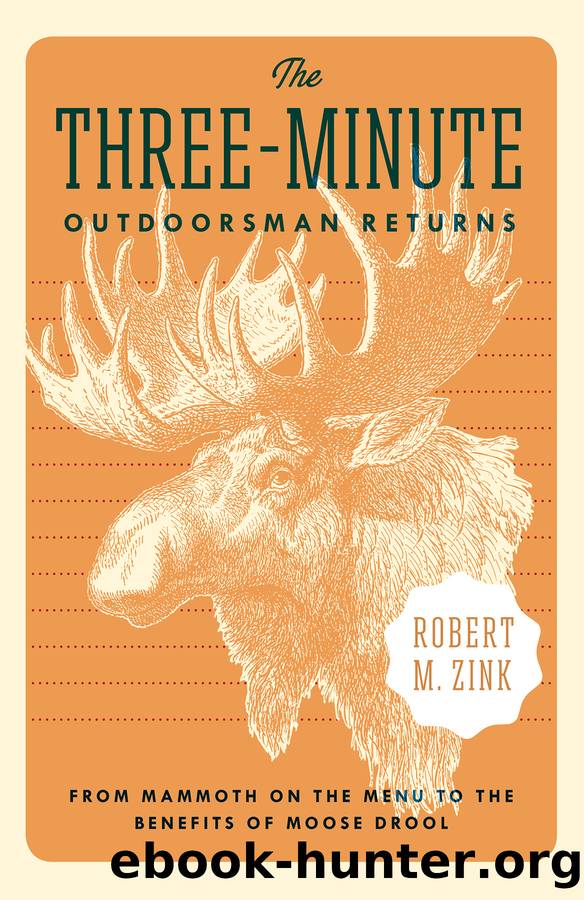The Three-Minute Outdoorsman Returns by Robert M. Zink

Author:Robert M. Zink [Zink, Robert M.]
Language: eng
Format: epub
Tags: NAT024000 Nature / Essays, SCI080000 Science / Essays, NAT001000 Nature / Animals / General
ISBN: 9781496212924
Publisher: University of Nebraska Press
Published: 2018-07-19T00:00:00+00:00
38
Why Are Pronghorns So Fast?
Watching pronghorns reach their almost blinding top speed is a thing of beauty. It seems that when they have reached top speed, which is impressive, they kick into an even higher gear. One would assume that such speed evolved for escaping predators, and this is probably true. Animals donât become fast just because they can; there is a reason somewhere in their history. We usually assume that the reason for the pronghornsâ speed exists in their current environment; otherwise why bother?
There arenât any predators in western North America today that are remotely as fast as the pronghorn. So why so fast, Mr. Pronghorn? A recent paper by Pavel Dobrynin and thirty-four (!) colleagues entitled âGenomic Legacy of the African Cheetah, Acinonyx jubatus,â published in Genome Biology, provided a possible hint. But first, what did the researchers do, and what is âgenome biologyâ?
I have reviewed many studies where genetic information was used to answer interesting biological questions. After all, genes, which tell how and where to build parts of organisms and how to operate them, are in a sense the blueprints of heredity. All of these studies used information from a few genes. Yet there are many thousands of genes in most organisms. (Humans, by the way, donât have the most genes; instead itâs the water flea, Daphnia!) More genes havenât been studied because the technology has been too difficult or too expensive. Today it is possible to economically gather information from thousands of genes. Genomics, then, is a somewhat loose term that means something between âa whole lot of genesâ and entire genomes. More and more it is becoming feasible to obtain entire genomes as a result of rapidly lowering costs.
The ability to study more genes leads to an improved understanding of the historical signatures or imprints left in genes. For example, if a species undergoes a drastic reduction in population sizeâsay, because of a drought or from being forced into small habitat areas during glacial advancesâthen the population loses genetic variability. Each gene in a population is usually represented in several different alleles and mostly they are able to do the same function more or less equally well. For example, if genes were marbles, and you started with one thousand red ones, one hundred blue ones, and ten white ones but then were forced to choose a total of ten, thereâs a chance the white marbles would not be represented. At some times, some alleles are much better at allowing a population to adapt to a new environment. Genetic variation is sort of like an insurance policy against a changing environment. Obviously environments always change, and extinction is a rule of life, so genetic variation doesnât always make populations bullet proof, but it helps species survive as long as they do.
Back to cheetahs and pronghorns. According to Dobrynin and colleagues, âCheetahs have elongated legs, slim aerodynamic skulls and enlarged adrenal glands, liver and heart, plus semi-retractable claws that grip the earth like football cleats as they race after prey at >120 km/hour.
Download
This site does not store any files on its server. We only index and link to content provided by other sites. Please contact the content providers to delete copyright contents if any and email us, we'll remove relevant links or contents immediately.
Bad Pharma by Ben Goldacre(2735)
How To by Randall Munroe(2492)
The Book of Numbers by Peter Bentley(2412)
Aliens by Jim Al-Khalili(2387)
A Short History of Nearly Everything by Bryson Bill(2138)
The Meaning of it All by Richard Feynman(1914)
Bill Bryson by A short history of nearly everything(1403)
A Short History of Nearly Everything: Special Illustrated Edition by Bill Bryson(1278)
Elephants on Acid by Boese Alex(1236)
Six Easy Pieces by Richard P. Feynman(1230)
Everything in Its Place by Oliver Sacks(1159)
The Meaning Of It All by Richard P. Feynman(1127)
Bad Science by Ben Goldacre(1106)
When Einstein Walked with Gödel by Jim Holt(1081)
One Two Three ... Infinity: Facts and Speculations of Science by George Gamow(1005)
A SHORT HISTORY OF NEARLY EVERYTHING by bryson bill(1001)
The American Scene by Henry James(996)
Glukhovsky, Dmitry - Metro 2033 by Glukhovsky Dmitry(939)
Leviathan Wakes by James S.A. Corey(935)
